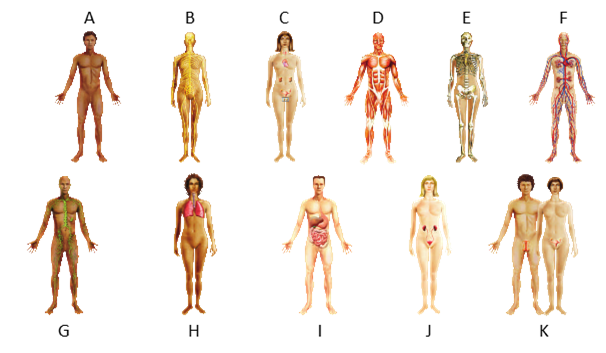Correct Answer
Multiple Choice
The ____ system delivers nutrients and oxygen to the cells.
A) respiratory
B) urinary
C) digestive
D) lymphatic
E) circulatory
Correct Answer

verified
Correct Answer
verified
Multiple Choice
____ glands release products onto an internal or external surface.
A) Endocrine
B) Muscular
C) Neural
D) Exocrine
E) Connective
Correct Answer

verified
Correct Answer
verified
Matching
 Match the organ system image from the figure above with the description below
Match the organ system image from the figure above with the description below
Correct Answer
Multiple Choice
Most epidermal cells are ___.
A) melanocytes
B) keratinocytes
C) collagenocytes
D) neuroglia
E) striated
Correct Answer

verified
Correct Answer
verified
Multiple Choice
____ tissue contains glands.
A) Connective
B) Muscular
C) Epithelial
D) Neural
E) Adipose
Correct Answer

verified
Correct Answer
verified
Matching
The questions refer to one of the four types of tissues found in animals. Match each statement with the appropriate tissue type.
Correct Answer
Multiple Choice
Evaporation of sweat helps ____ a(n) ____ body temperature.
A) lower; depressed
B) raise; depressed
C) lower; elevated
D) raise; elevated
E) maintain; average
Correct Answer

verified
C
Correct Answer
verified
Multiple Choice
The ____ system is responsible for filtering wastes from the blood.
A) respiratory
B) urinary
C) digestive
D) endocrine
E) circulatory
Correct Answer

verified
Correct Answer
verified
Multiple Choice
____ in the skin protects us from harmful ultraviolet light energy.
A) Keratin
B) Collagen
C) Elastin
D) Myosin
E) Melanin
Correct Answer

verified
Correct Answer
verified
Matching
The questions refer to one of the four types of tissues found in animals. Match each statement with the appropriate tissue type.
Correct Answer
Multiple Choice
Keeping internal conditions within tolerable limits is called ____.
A) maintenance
B) anatomy
C) physiology
D) homeostasis
E) equilibrium
Correct Answer

verified
Correct Answer
verified
Multiple Choice
Vertebrate lungs originally evolved from ____.
A) fish gills
B) fish guts
C) lizard gills
D) lizard guts
E) salamander gills
Correct Answer

verified
Correct Answer
verified
Multiple Choice
Only ____ can be voluntarily controlled.
A) skeletal muscles
B) cardiac muscles
C) smooth muscles
D) dense connective tissue
E) loose connective tissue
Correct Answer

verified
A
Correct Answer
verified
Matching
The questions refer to one of the four types of tissues found in animals. Match each statement with the appropriate tissue type.
Correct Answer
Multiple Choice
A tissue is defined as ____.
A) one or more cell types that perform a common task
B) a cell that is unique in its function
C) various cells that perform different functions
D) the structural unit of an organ system
E) one or more organ types that perform a common task
Correct Answer

verified
Correct Answer
verified
Multiple Choice
The human body temperature is 37o Celsius. If a person goes outside on a very cold day, the temperature will still be close to 37 o Celsius. This is an example of ____.
A) pluripotency
B) homology
C) homeostasis
D) differentiation
E) regeneration
Correct Answer

verified
Correct Answer
verified
Multiple Choice
____ tissue can be thought of as analogous to a central switchboard.
A) Epithelial
B) Connective
C) Nervous
D) Muscle
E) Endocrine
Correct Answer

verified
Correct Answer
verified
Multiple Choice
The kidneys are protected by ____ tissue.
A) adipose
B) loose irregular connective
C) dense regular connective
D) stratified cuboidal epithelium
E) simple squamous epithelium
Correct Answer

verified
Correct Answer
verified
Multiple Choice
____ epithelial tissue is several cell layers thick.
A) Stratified
B) Loose connective
C) Dense connective
D) Simple
E) Cuboidal
Correct Answer

verified
Correct Answer
verified
Showing 1 - 20 of 100
Related Exams